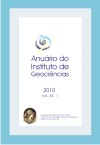Gravity data interpretation in the northern edge of the Congo Craton, South-Cameroon
DOI:
https://doi.org/10.11137/2010_1_73-82Abstract
Gravity data in the southern Cameroon are interpreted to better understand the organization of underlying structures throughout the northern edge of the Congo craton. The Bouguer anomaly maps of the region are characterized by an elongated SW-NE trending negative gravity anomaly which correspond to a collapsed structure associated with a granitic intrusion beneath the center of the region and limited by fault systems. We applied 3-D gravity modelling and inversion in order to obtain the 3-D density structure of the area. Our result demonstrated that observed gravity anomalies in the region are associated to tectonic structures in the subsurface. The resulting model agrees with the hypothesis of the existence of a major continental collision zone between the Congo Craton and the Pan-African belt. The presence of deep granulites structures in the northern part of the region expresses a continental collision.Downloads
Download data is not yet available.
Downloads
Published
2010-06-01
How to Cite
Shandini, Y. N. (2010) “Gravity data interpretation in the northern edge of the Congo Craton, South-Cameroon”, Anuário do Instituto de Geociências. Rio de Janeiro, BR, 33(1), pp. 73–82. doi: 10.11137/2010_1_73-82.
Issue
Section
não definida
License
This journal is licensed under a Creative Commons — Attribution 4.0 International — CC BY 4.0, which permits use, distribution and reproduction in any medium, provided the original work is properly cited.















